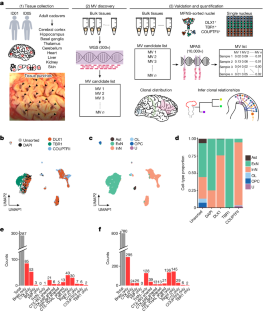2004-04-16 カリフォルニア大学サンディエゴ校(UCSD)
<関連情報>
- https://today.ucsd.edu/story/following-cellular-lineage
- https://www.nature.com/articles/s41586-024-07292-5
ヒト前脳のクローンダイナミクスを細胞型分解モザイクで解明 Cell-type-resolved mosaicism reveals clonal dynamics of the human forebrain
Changuk Chung,Xiaoxu Yang,Robert F. Hevner,Katie Kennedy,Keng Ioi Vong,Yang Liu,Arzoo Patel,Rahul Nedunuri,Scott T. Barton,Geoffroy Noel,Chelsea Barrows,Valentina Stanley,Swapnil Mittal,Martin W. Breuss,Johannes C. M. Schlachetzki,Stephen F. Kingsmore & Joseph G. Gleeson
Nature Published:10 April 2024
DOI:https://doi.org/10.1038/s41586-024-07292-5

Abstract
Debate remains around the anatomical origins of specific brain cell subtypes and lineage relationships within the human forebrain1,2,3,4,5,6,7. Thus, direct observation in the mature human brain is critical for a complete understanding of its structural organization and cellular origins. Here we utilize brain mosaic variation within specific cell types as distinct indicators for clonal dynamics, denoted as cell-type-specific mosaic variant barcode analysis. From four hemispheres and two different human neurotypical donors, we identified 287 and 780 mosaic variants, respectively, that were used to deconvolve clonal dynamics. Clonal spread and allele fractions within the brain reveal that local hippocampal excitatory neurons are more lineage-restricted than resident neocortical excitatory neurons or resident basal ganglia GABAergic inhibitory neurons. Furthermore, simultaneous genome transcriptome analysis at both a cell-type-specific and a single-cell level suggests a dorsal neocortical origin for a subgroup of DLX1+ inhibitory neurons that disperse radially from an origin shared with excitatory neurons. Finally, the distribution of mosaic variants across 17 locations within one parietal lobe reveals that restriction of clonal spread in the anterior–posterior axis precedes restriction in the dorsal–ventral axis for both excitatory and inhibitory neurons. Thus, cell-type-resolved somatic mosaicism can uncover lineage relationships governing the development of the human forebrain.


